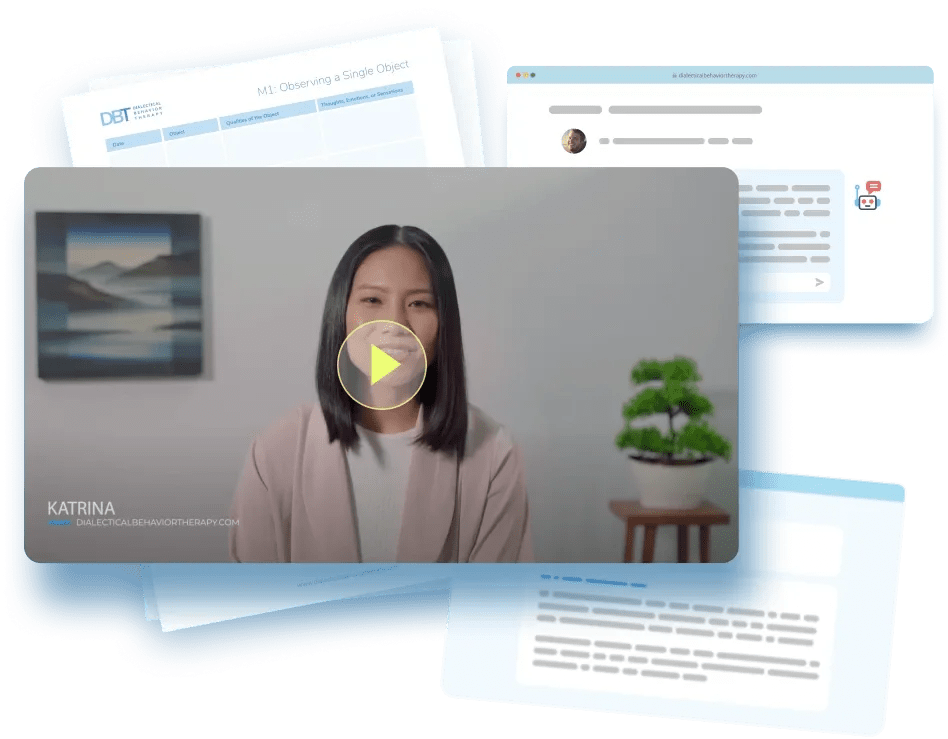SM4: ABC Thought Tracker
Virtual Coach
Work step-by-step through the Self-Monitoring & Awareness exercise with the virtual coach.
Introduction
Noticing how emotions and thoughts unfold in real time takes practice. Tools like the Automatic Thought Log and Mood Snapshots help track patterns across your day, while Timeline Mapping places those patterns in context. The next step is to catch the chain of events as it happens... starting with the trigger, the belief, and the consequence.
Imagine you get a short email from your manager: “See me.”
- Antecedent (A): Inbox ping at 2:07 p.m.
- Belief (B): “I’m in trouble. I must have messed up the report.”
- Consequence (C): Jolt of anxiety (7/10) → you avoid the meeting and keep refreshing the message thread.
Most of us experience that three-part chain dozens of times a day without noticing it. The ABC Thought Tracker slows the process so you can see each link in real time. Once you know what happened (A), what you told yourself (B), and how you felt or acted (C), you’ll have the raw data you need for cognitive restructuring later on.
Instructions
Goal: Complete one ABC entry per day for two weeks.
Time per entry: 5–7 minutes (right after the event or at the end of your day).
Step 1: Settle In
Before writing, take two slow, mindful breaths. Find a quiet place where you won’t be interrupted. This is a time to tune in, not to judge or fix.
Step 2: Recall a Moment
Think back to a situation today that stirred something in you. It may have been frustrating, uncomfortable, or simply unexpected. Choose one moment to explore using the ABC format below.
A – Antecedent
What happened? Write down the factual details: who, what, where, and when.
Keep it neutral! No interpretations, just the observable facts.
Example: “Slack DM from team lead: ‘Can we talk for a second?’”
B – Belief
What thought immediately popped into your head? Write it down exactly as it came to you. Don’t revise or soften it.
This is your mind’s interpretation, not the objective truth.
Example: “I must be in trouble.”
C – Consequence
What did you feel and do next? Split your response into:
• Emotion: Name the feeling and rate its intensity (0–10)
• Behavior: What action did you take?
You may also note physical body cues (tight chest, racing heart, etc.).
Example: Emotion – Anxiety (7); Behavior – Avoided opening the message; Body – Chest tight
Step 3: Optional Evidence Check
After writing your ABC, briefly ask yourself:
• What is the proof for this belief?
• What is the proof against it?
Just jot a line or two. This is not about editing the thought, just noticing its validity.
Step 4: End-of-Week Review
Scan your entries at the end of the week. Highlight any beliefs that show up repeatedly or emotions that seem to spike.
These patterns can guide your focus in Modules 2 and 4.
This exercise is about building awareness, not changing yourself overnight. The more entries you create, the more clearly you’ll see the connection between your thoughts, emotions, and behavior.
FAQs
What if I don’t remember exactly what I was thinking during the situation?
That’s completely normal. Just try to write down the first thought that comes to mind when you recall the event. Even a rough memory can give you useful insight. This skill gets easier with practice.
How is the “Belief” (B) different from my emotion?
The Belief is the automatic thought that popped into your mind, the story or interpretation. The Consequence is what you felt or did next. For example:
- Belief – “I’m a failure”
- Emotion – Shame (8/10)
- Behavior – I shut down and avoided replying
What if the same thought keeps showing up in different entries?
That’s a good sign! It means you’ve found a core belief that might be shaping your emotional reactions. You can highlight repeated beliefs and explore them further using cognitive restructuring skills later on.
Do I have to fill out all five steps every day?
Not at all. Some days, you might only have time to jot down A, B, and C. The key is consistency, not perfection. You’ll start to notice patterns even with brief entries.
Disclaimer
If you have any behavioral health questions or concerns, please talk to your healthcare or mental healthcare provider. This article is supported by peer-reviewed research and information drawn from behavioral health societies and governmental agencies. However, it is not a substitute for professional behavioral health advice, diagnosis, or treatment.

